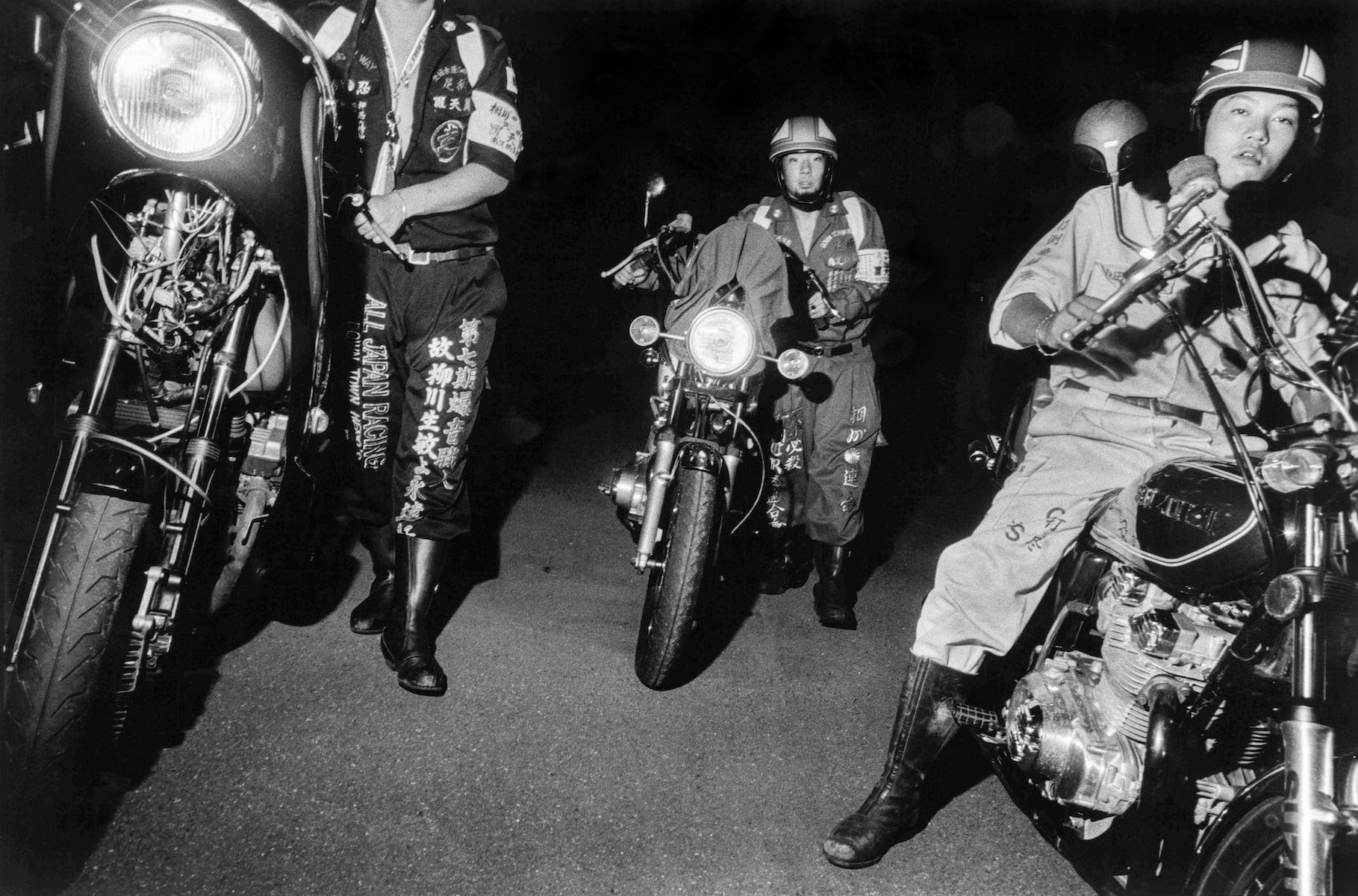Photos documenting Japan’s underground subcultures
- Text by Isaac Muk
- Photography by Bruce Gilden

In the heady spring of 1974, a young Bruce Gilden went to see the latest exhibition at New York’s Museum of Modern Art (MoMA). Adorning the walls was New Japanese Photography, a collection of shots from the most eminent photographers from the East Asian archipelago.
The exhibition provided a glimpse into Japanese art, culture, and daily life – featuring photographers such as Shomei Tomatsu, Yasuhiro Ishimoto, Daido Moriyama and Masahisa Fukase. Gilden was drawn in: “They were influenced by [western] photographers like Ed van der Elsken and William Klein – yet they had their own take on it,” he says.
Feeling inspired, but also an urge to compete with their work, Gilden asked himself: “If they take good pictures there, why can’t I?”

JAPAN. Asakusa. 1998. Two members of the Yakuza, Japan’s mafia.
“It only took me 20 years to get there,” he says, with a wry smile. “The thing is when I arrived there, it wasn’t the 1960s or 70s, it was 1995, so it totally changed.”
His recently published book, Cherry Blossom, is a collection of photographs from his travels to Japan between 1995 and 1999. Venturing to Tokyo, Osaka and beyond, Gilden sought out the colourful and unexpected characters, taking him far off the beaten track for tourists, capturing it all in his own up close and personal, uncompromising style.
Spanning tattooed Yakuza gang members, homeless people living on the streets and smart-suited young men sporting greased back teddy boy haircuts, the photos explore the diverse array of characters and cultures within Japanese society before the turn of the century.

Businessman at lunchtime outside JR station. Tokyo, Kaeda, 1996.

Japan, 1999.
Prominently featured is the San’ya district in northeast Tokyo, an area that was met with bemused reactions from locals upon mention. Gilden says that when he told people that his favourite place to take photographs in the capital was San’ya, the usual response would be: ‘Where?’
“I’m sure they knew the name but they didn’t want to admit they knew of San’ya, or maybe there was a place like San’ya in Tokyo,” he says. “It’s a very interesting area, but also dangerous, because some people don’t like westerners – and some people are a little crazy. It’s a place where a few journalists have gotten killed.”
These journalists Gilden refers to were the directors of Yama—Attack to Attack, a 1985 documentary about the infamous district, who were murdered by members of a Yakuza gang.

Japan, 1999.
The Yakuza’s reputation as hardened, dangerous criminals still didn’t stop Gilden from searching them out for photos, which landed him in a few hairy situations. In Osaka, he ended up in a fistfight with a “low-level” gang member, who took exception with him taking a photograph.
“He was drunk and telling me, ‘you can’t do that’, and I’m like ‘mind your own fucking business’,” Gilden says. “I was with a Japanese person who was taking me around and they had to separate us.”
Why doesn’t he shy away from putting himself in potential danger? “My father was a gangster, so I know how to act around them. I’m very comfortable – you give respect, you get respect,” he says.

Right-Wing Nationalist at Yasakuni temple. Japan, Kyoto, 1999.
Years later, Gilden’s work has led to him meeting some of the photographers who originally contributed to the New Japanese Photography exhibition, including having dinner with Shomei Tomatsu and sharing an exhibition at a gallery with Daido Moriyama.
Sadly, he was unable to meet Masahisa Fukase. “He fell down a flight of stairs,” Gilden says. (Fukase died in 2012, having been in a coma for 20 years following a near-fatal fall down the stairs of his favourite bar in 1992.) “It’s interesting, because his photographs always for me were very violent, and that’s who he is.
“And that’s what makes the photographs so good – because you can only photograph who you are.”

Bikers leave motorcycle meeting while being chased by police. Kamonomiya, 1999.

Homeless couple, Japan, 1996.
Cherry Blossom is published by Thames and Hudson and is available now.
Follow Isaac Muk on Twitter.
Enjoyed this article? Like Huck on Facebook or follow us on Twitter and Instagram.
Latest on Huck

The inner-city riding club serving Newcastle’s youth
Stepney Western — Harry Lawson’s new experimental documentary sets up a Western film in the English North East, by focusing on a stables that also functions as a charity for disadvantaged young people.
Written by: Isaac Muk

The British intimacy of ‘the afters’
Not Going Home — In 1998, photographer Mischa Haller travelled to nightclubs just as their doors were shutting and dancers streamed out onto the streets, capturing the country’s partying youth in the early morning haze.
Written by: Ella Glossop

See winners of the World Press Photo Contest 2025
A view from the frontlines — There are 42 winning photographers this year, selected from 59,320 entries.
Written by: Zahra Onsori

Inside Kashmir’s growing youth tattoo movement
Catharsis in ink — Despite being forbidden under Islam, a wave of tattoo shops are springing up in India-administered Kashmir. Saqib Mugloo spoke to those on both ends of the needle.
Written by: Saqib Mugloo

The forgotten women’s football film banned in Brazil
Onda Nova — With cross-dressing footballers, lesbian sex and the dawn of women’s football, the cult movie was first released in 1983, before being censored by the country’s military dictatorship. Now restored and re-released, it’s being shown in London at this year’s BFI Flare film festival.
Written by: Jake Hall

In the dressing room with the 20th century’s greatest musicians
Backstage 1977-2000 — As a photographer for NME, David Corio spent two decades lounging behind the scenes with the world’s biggest music stars. A new photobook revisits his archive of candid portraits.
Written by: Miss Rosen